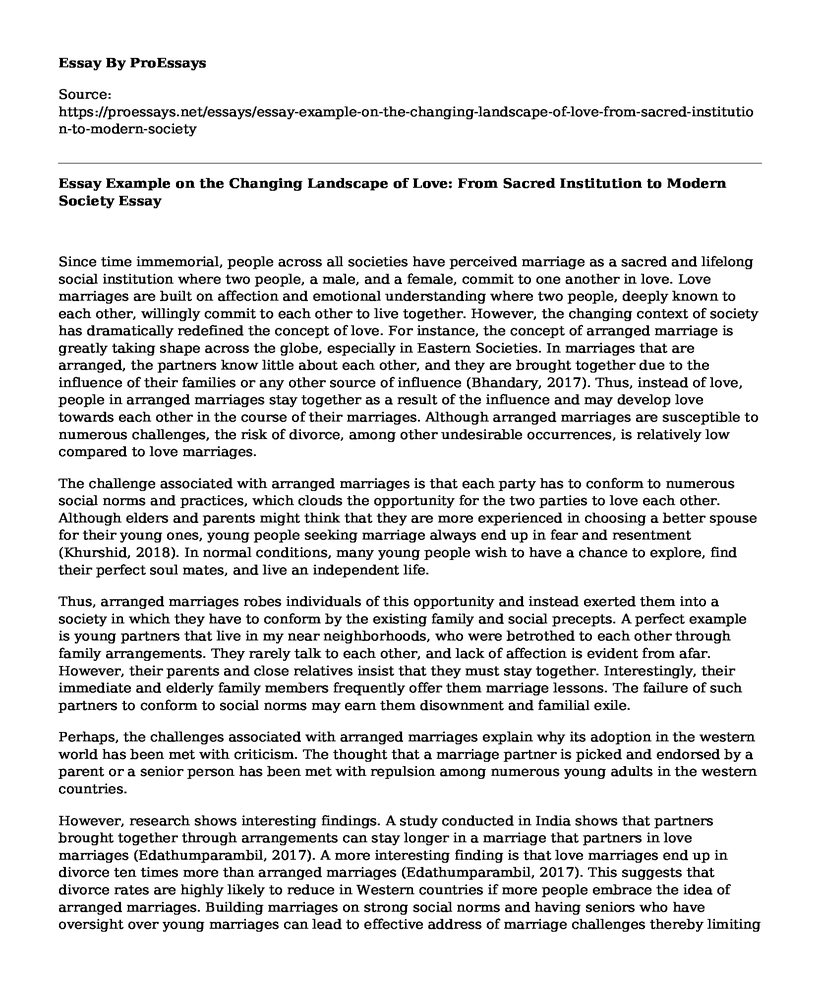Since time immemorial, people across all societies have perceived marriage as a sacred and lifelong social institution where two people, a male, and a female, commit to one another in love. Love marriages are built on affection and emotional understanding where two people, deeply known to each other, willingly commit to each other to live together. However, the changing context of society has dramatically redefined the concept of love. For instance, the concept of arranged marriage is greatly taking shape across the globe, especially in Eastern Societies. In marriages that are arranged, the partners know little about each other, and they are brought together due to the influence of their families or any other source of influence (Bhandary, 2017). Thus, instead of love, people in arranged marriages stay together as a result of the influence and may develop love towards each other in the course of their marriages. Although arranged marriages are susceptible to numerous challenges, the risk of divorce, among other undesirable occurrences, is relatively low compared to love marriages.
The challenge associated with arranged marriages is that each party has to conform to numerous social norms and practices, which clouds the opportunity for the two parties to love each other. Although elders and parents might think that they are more experienced in choosing a better spouse for their young ones, young people seeking marriage always end up in fear and resentment (Khurshid, 2018). In normal conditions, many young people wish to have a chance to explore, find their perfect soul mates, and live an independent life.
Thus, arranged marriages robes individuals of this opportunity and instead exerted them into a society in which they have to conform by the existing family and social precepts. A perfect example is young partners that live in my near neighborhoods, who were betrothed to each other through family arrangements. They rarely talk to each other, and lack of affection is evident from afar. However, their parents and close relatives insist that they must stay together. Interestingly, their immediate and elderly family members frequently offer them marriage lessons. The failure of such partners to conform to social norms may earn them disownment and familial exile.
Perhaps, the challenges associated with arranged marriages explain why its adoption in the western world has been met with criticism. The thought that a marriage partner is picked and endorsed by a parent or a senior person has been met with repulsion among numerous young adults in the western countries.
However, research shows interesting findings. A study conducted in India shows that partners brought together through arrangements can stay longer in a marriage that partners in love marriages (Edathumparambil, 2017). A more interesting finding is that love marriages end up in divorce ten times more than arranged marriages (Edathumparambil, 2017). This suggests that divorce rates are highly likely to reduce in Western countries if more people embrace the idea of arranged marriages. Building marriages on strong social norms and having seniors who have oversight over young marriages can lead to effective address of marriage challenges thereby limiting chances of divorce.
Conclusion
In conclusion, arranged marriage might exhibit greater benefits as compared to love marriage, despite its impending challenges. Consistent with the traditional fact that marriage is a lifelong institution, arranged marriages compel couples to live as per some social norms that are essential in ensuring that such marriages stay intact as long as possible. Although individuals might not have the opportunity to choose their mates according to their affections, they can still develop love and affection in the course of their marriage. Therefore, there is a need to promote the concept of arranged marriages as an option for reducing the rate of divorce in Western countries.
References
Bhandary, A. (2017). Arranged marriage: Could it contribute to justice? Journal of Political Philosophy, 26(2), 193-215. https://doi.org/10.1111/jopp.12144
Edathumparambil, B. (2017). Strangers to spouses: A study of the relationship quality in arranged marriages in India. Wipf and Stock Publishers.
Khurshid, A. (2018). Love marriage or arranged marriage? Choice, rights, and empowerment for educated Muslim women from rural and low-income Pakistani communities. Compare: A Journal of Comparative and International Education, 50(1), 90-106. https://doi.org/10.1080/03057925.2018.1507726
Cite this page
Essay Example on the Changing Landscape of Love: From Sacred Institution to Modern Society. (2023, Jul 18). Retrieved from https://proessays.net/essays/essay-example-on-the-changing-landscape-of-love-from-sacred-institution-to-modern-society
If you are the original author of this essay and no longer wish to have it published on the ProEssays website, please click below to request its removal:
- Investigation of Behavioral Management Policies in School Paper Example
- Essay Sample on Personalities in the Workplace
- Essay Sample on Unlock Your Boundaries: The Future of Career Success
- Self-Theory - A Definition of Personal Identity - Essay Sample
- Paper Example on IQ Score Variance in Student: Case Study
- Impulse Control Disorder: Common Among Ages, Genders, Lifestyles & Genes - Essay Sample
- Human Factors: Understanding the SHELL Model for Accidents - Essay Sample







